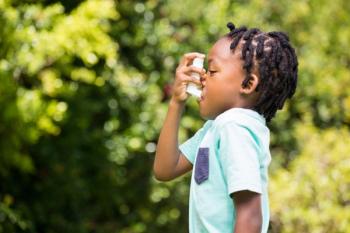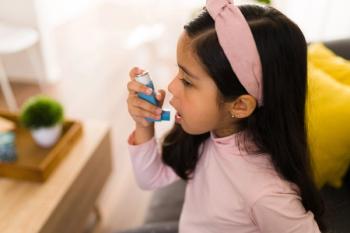
- Consultant for Pediatricians Vol 6 No 1
- Volume 6
- Issue 1
Foreign-Body Aspiration: A Guide to Early Detection, Optimal Therapy
ABSTRACT: Because foreign-body aspiration can cause symptoms that mimic those of other respiratory conditions, a high index of suspicion is crucial in all children who have pneumonia, atelectasis, or wheezing with an atypical course--especially when these conditions are unresponsive to usual medical therapy. A history of choking can usually be elicited in a patient who has aspirated a foreign body: such a history should be sought when respiratory symptoms develop suddenly. However, the absence of a choking history does not rule out foreign-body aspiration. Moreover, patients may be asymptomatic initially. Normal radiographic findings do not exclude an aspirated foreign body. Bronchoscopy should be strongly considered when an aspirated foreign body is suspected, even if radiographic images show normal findings. Rigid bronchoscopy is the procedure of choice for removing aspirated foreign bodies in children. Prevention of foreign-body aspiration can be enhanced through anticipatory guidance of parents/caregivers and through continued product safety efforts.
Foreign-body aspiration is a relatively common occurrence in children. It may present as a life-threatening event that necessitates prompt removal of the aspirated material. However, the diagnosis may be delayed when the history is atypical, when parents fail to appreciate the significance of symptoms, or when clinical and radiologic findings are misleading or overlooked by the physician.
Aspiration of organic matter causes severe airway mucosal inflammation. If the organic matter is not promptly removed, chronic inflammation leads to the development of granulation tissue around the foreign body, which may ultimately present as a lung infection. In this setting, it is not uncommon to treat patients for secondary complications, such as persistent fever, "asthma," or recurrent pneumonia for long periods.
Here we review the incidence of foreign-body aspiration, its various clinical guises, its management, and measures that can prevent future aspirations.
Upper Airway Obstruction
Upper airway obstruction is one of the leading causes of pediatric emergencies. According to the National SafetyCouncil, mechanical suffocation accountedfor 5% of all unintentional deaths among children younger than 4 years in 1995 in the United States.1 Most of these deaths involved children younger than 12 months (10% of all unintentional deaths occurred in this age group).2
Pathogenesis. A foreign body in the posterior pharynx causes irritation and discomfort that causes the child to cry or cough. Vigorous inspiration causes the foreign body to become impacted within the airway; there is increased resistance to inspiratory and expiratory flow as a result. The impacted foreign body in the intrathoracic airway creates a valve-like effect that causes more airflow obstruction during expiration than during inspiration; the result is generalized or asymmetric gas trapping. Surface sensory receptors of the respiratory tract adapt to the prolonged pressure caused by the foreign body. Consequently, the child will not experience further coughing until other sensory receptors are stimulated by dislodgment of the foreign body or by secretions. Thus the patient may be asymptomatic for some time (ie, hours to months or even longer).
Epidemiology. Foreign-body aspiration accounts for more than 300 deaths annually in this country.3 Approximately 80% of episodes of foreign-body aspiration occur in those younger than 3 years.4 Most children of this age are learning to explore their world via the oral route and tend to put everything in their mouth. The absence of the molars makes them unable to chew adequately, however. These factors increase the risk of foreign-body aspiration. Other predisposing factors include older siblings who may place food or objects in the mouth of infants or toddlers; neurologic disorders, such as cerebral palsy; loss of consciousness; and swallowing dysfunction.
During infancy, the incidence of foreign-body aspiration episodes is equal in boys and girls. After infancy, however, boys are more likely to experience aspiration than girls: the male-to-female ratio varies from 1.5:1 to 2.4:1.4,5
Food items (nuts, seeds, food particles) have been implicated in 70% to 90% cases involving infants and toddlers.6 Various types of nuts top the list of aspirated foreign bodies: peanuts are the most common (36% to 55%).5,7 Melon and sunflower seeds are also commonly aspirated.8
Older children tend to aspirate non-food items, such as paper clips, coins, balls, marbles, and pins.6 Balloon aspiration is frequently fatal.9 Balloons can pass through the vocal cords and lodge in the carina; they prevent air passage through to the lungs. As a result, balloons have been banned in many day-care centers and schools.MANAGEMENT
Clinical management of an aspirated foreign body includes early recognition, acute emergency interventions, supportive care, and preventive anticipatory guidance.
Thecurrent guidelines for pediatric basic life support recommend that when airway obstruction from a foreign body is mild, no intervention is required.23 The patient should be allowed to clear his or her airway by coughing while the clinician watches for signs of impending severe airway obstruction.
In infants with severe obstruction, 5 back blows followed by 5 chest thrusts should be administered repeatedly until the object is expelled or the victim becomes unresponsive. Abdominal thrusts should not be delivered to infants because they may damage the relatively large and unprotected liver.23
For children older than 1 year, subdiaphragmatic abdominal thrusts (the Heimlich maneuver) should be administered. These maneuvers force the diaphragm upward, there-by increasing the intrathoracic and intratracheal pressure that expels the foreign body. These maneuvers should be performed only if the child is responsive.
Cardiopulmonary resuscitation should be performed if a child becomes unresponsive. Rescuers should always look into the mouth before giving breaths. Keep in mind that a blind oropharyngeal finger sweep in a chokinginfant or child can dislodge the foreign body to the more distal and smaller airways. A finger sweep should be done only if the object can be seen in the posteriorpharynx. Ventilation followed by chest compressions should follow. Parents and caregivers should learn thesetechniques to prevent accidental deaths from foreign-body aspiration.23
Bronchoscopy is used to remove the foreign body. Since the advent of bronchoscopy, mortality associated with foreign-body aspiration has decreased from 50% to 1%.1 Bronchoscopy should be done at an intensive care facility because some children need postoperative ventilation. Rigid bronchoscopy is considered the standard of care in many centers for evaluating a child with possible aspiration. This procedure allows for better visualization of the airways, for manipulation of the foreign body with a variety of forceps, and for better control of mucosal hemorrhage should this occur. Rigid bronchoscopy also helps maintain good airway control.24 A Fogarty catheter, an alligator cathe-ter, and 4-pronged flexible grasping hooks are used to remove the foreign body through the bronchoscope.
Flexible bronchoscopy is used to evaluate a child who presents with recurrent pneumonia or chronic cough when foreign-body aspiration is not suspected. The flexible bronchoscope avoids the need for general anesthesia and is thus considered by some experts to be safer and more cost- effective than rigid bronchoscopy.25 Foreign-body dislodgement is the main complication encountered with the flexible scope.
After the foreign body is removed, the airway should be visualized again for another foreign body or residual fragments. Postoperative complications may include atelectasis, worsening of the pneumonia, laryngeal edema, and pneumothorax. Cardiac arrest from hypoxia and massive bleeding is a rare occurrence.26
Ancillary treatment (ie, antibiotics) can be administered to treat infection that may have developed secondary to prolonged impaction. A course of systemic corticosteroids may help reduce inflammation27 and thus facilitate the removal of the foreign body.
Chest physical therapy and postural drainage may dislodge the foreign body to an area where it may cause more harm.
Prolonged foreign-body impaction in the airways triggers production of granulation tissue. This increases morbidity and repeated bronchoscopies may be needed to remove the foreign body.7
PREVENTION
The American Academy of Pediatrics recommends that anticipatory guidance be provided to parents and caregivers when their child is 6 months old.28 Children at this age begin to develop the fine motor skills needed to pick up and ingest small objects. Because food items (such as peanuts) are commonly aspirated, advise parents and caregivers not to offer such foods until their child is old enough to chew themproperly. Also advise parents to feed their child only when he is sitting upright and to discourage the child from running, playing, or laughing while eating. Remind parents to place all small objects(such as pins and coins) safely out of the child's reach.
The Consumer Product Safety Act was enacted in an effort to prevent foreign-body aspiration. The act recommends a ban on any toys that could pose choking or aspiration hazards for children younger than 3 years.9 Since 1995, any toy with small parts, marbles, or balls less than 4.44 cm in size must carry a label that the item contains small parts and that it is not recommended for young children.29
References:
REFERENCES:
1.
Rovin JD, Rodgers BM. Pediatric foreign body aspiration.
Pediatr Rev.
2000;21:86-90.
2.
Schmidt H, Manegold BC. Foreign body aspiration in children.
Surg Endosc.
2000;14:644-648.
3.
Black RE, Johnson DG, Matiak ME. Bronchoscopic removal of foreign bodies in children.
J Pediatr Surg.
1994;29:682-684.
4.
Rothmann BF, Boeckman CR. Foreign bodies in the larynx and tracheobronchial tree in children. A review of 225 cases.
Ann Otol Rhinol Laryngol.
1980;89:434-436.
5.
Burton EM, Brick WG, Hall JD, et al. Tracheobronchial foreign body aspiration in children.
South Med J.
1996;89:195-198.
6.
Darrow DH, Holinger LD. Aerodigestive tract foreign bodies in the older child and adolescent.
Ann Otol Rhinol Laryngol.
1996;105:267-271.
7.
Tan HK, Brown K, McGill T, et al. Airway foreign bodies (FB): a 10-year review.
Int J Pediatr Otolarygol.
2000;56:91-99.
8.
Pasaoglu I, Dogan R, Demircin M, et al. Bronchoscopic removal of foreign bodies in children: retrospective analysis of 822 cases.
Thorac Cardiovasc Surg.
1991;39:95-98.
9.
Rimell FL, Thome A Jr, Stool S, et al. Characteristics of objects that cause choking in children.
JAMA.
1995;274:1763-1766.
10.
Mu L, He P, Sun D. Inhalation of foreign bodies in Chinese children: a review of 400 cases.
Laryngoscope.
1991;101:657-660.
11.
Lima JA. Laryngeal foreign bodies in children: a persistent, life-threatening problem.
Laryngoscope.
1989;99:415-420.
12.
Even L, Heno N, Talmon Y, et al. Diagnostic evaluation of foreign body aspiration in children: a prospective study.
J Pediatr Surg.
2005;40:1122-1127.
13.
Lima AB, Fischer GB. Foreign body aspiration in children.
Paed Resp Rev.
2002;3:303-307.
14.
De Bilderling G, Mathot M, Bodart E.Asthma in the young child: when should inhaled foreign body be suspected?
Rev Med Liege.
2001;56:759-763.
15.
Tokar B, Ozkan R, Ilhan H. Tracheobronchial foreign bodies in children: importance of accurate history and plain chest radiography in delayed presentation.
Clin Radiol.
2004;59:609-615.
16.
Narasimhan KL, Chowdhary SK, Suri S, et al. Foreign body airway obstructions in children: lessons learnt from a prospective audit.
J Indian Assoc Pediatr Surg.
2002;7:184-189.
17.
Reilly J, Thompson J, MacArthur C, et al. Pediatric aerodigestive foreign body injuries are complications related to timeliness of diagnosis.
Laryngoscope.
1997;107:17-20.
18.
Cataneo AJ, Reibscheid SM, Ruiz Junior RL, Ferrari GF. Foreign body in the tracheobronchial tree.
Clin Pediatr.
1997;36:701-706.
19.
Silva AB, Muntz HR, Clary R. Utility of conventional radiography in the diagnosis and management of pediatric airway foreign bodies.
Ann Otol Rhinol Laryngol.
1998;107:834-838.
20.
Svedstrom E, Puhakka H, Kero P. How accurate is chest radiography in the diagnosis of tracheobronchial foreign bodies in children?
Pediatr Radiol.
1989;19:520-522.
21.
Mu LC, Sun DQ, He P. Radiological diagnosis of aspirated foreign bodies in children: review of 343 cases.
J Laryngol Otol.
1990;104:778-782.
22.
Appelgate KE, Dardinger JT, Leiber ML, et al. Spiral CT scanning technique in the detection of aspiration of LEGO foreign bodies.
Pediatr Radiol.
201;31:836-840.
23.
American Heart Association Guidelines for Cardiopulmonary Resuscitation and Emergency Cardiovascular Care: Pediatric Basic Life Support.
Circulation.
2005;112:156-166.
24.
Banerjee A, Rao KS, Khanna SK, et al. Laryngo-tracheo-bronchial foreign bodies in children
. J Laryngol Otol.
1988;102:1029-1032.
25.
Martinot A, Closset M, Marquette CH, et al. Indications for flexible versus rigid bronchoscopy in children with suspected foreign-body aspiration.
Am J Respir Crit Care Med.
1997;155:1676-1679.
26.
Ciftci AO, Bingol-Kologlu M, Senocak ME, et al.Bronchoscopy for evaluation of foreign body aspiration in children.
J Pediatr Surg.
2003;38:1170-1176.
27.
Steen KH, Zimmermann T. Tracheobronchial aspiration of foreign bodies in children: a study of 94 cases.
Laryngoscope.
1990;100:525-530.
28.
American Academy of Pediatrics.
Guidelines for Health Supervision III.
3rd ed. Elk Grove Village, Ill: American Academy of Pediatrics; 1997:91.
29.
Mechanical airway obstruction: choking, strangulation, and suffocation. In: Widome MD, ed.
Injury Prevention and Control for Children and Youth.
Elk Grove Village, Ill: American Academy of Pediatrics. 1997:285.
Articles in this issue
almost 19 years ago
Polydactyly of the handalmost 19 years ago
Photoclinic: Systemic Allergic Reaction to Embedded Sewing Needlealmost 19 years ago
"Focus on Vaccines" Correction:almost 19 years ago
Thyroglossal Duct Cyst in an 8-Year-Old Girlalmost 19 years ago
Pityriasis Rosea and Hot Tub Folliculitisalmost 19 years ago
Perianal Finding--Sexual Abuse or Normal Variant?almost 19 years ago
Photoclinic: Bilateral Clinodactyly of the Fifth Fingeralmost 19 years ago
Photo Quiz: Making the Rounds: Round 1almost 19 years ago
Top Papers Of The Month: Cough Medicine as a Drug of Abusealmost 19 years ago
Photoclinic: Giant Congenital Melanocytic NevusNewsletter
Access practical, evidence-based guidance to support better care for our youngest patients. Join our email list for the latest clinical updates.














